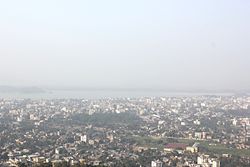Kamrup Metropolitan district
Thank you for being part of the Bharatpedia family! 0% transparency: ₹0 raised out of ₹100,000 (0 supporter) |
Kamrup Metropolitan district | |
|---|---|
 View of Guwahati from Narakasur Hill | |
 | |
| Coordinates: 26°11′0″N 91°44′0″E / 26.18333°N 91.73333°ECoordinates: 26°11′0″N 91°44′0″E / 26.18333°N 91.73333°E | |
| Country | |
| State | Assam |
| Division | Lower Assam |
| Headquarters | Guwahati |
| Government | |
| • Lok Sabha constituencies | Gauhati |
| • Vidhan Sabha constituencies | Jalukbari, Dispur, Gauhati East, Gauhati West |
| Area | |
| • Total | 1,527.84 km2 (589.90 sq mi) |
| Population (2011) | |
| • Total | 1,253,938 |
| • Density | 820/km2 (2,100/sq mi) |
| Time zone | UTC+05:30 (IST) |
| ISO 3166 code | IN-AS |
| Website | kamrupmetro.in |
Kamrup Metropolitan district is one of the 34 districts in Assam state in north-eastern India. It was carved out of the erstwhile undivided Kamrup district in 2003 and covers an area equivalent to the area under the jurisdiction of the Guwahati Metropolitan Development Authority area. Dispur Legislative Assembly Constituency in Kamrup Metro district with 3.53 lakh voters is the largest constituency in Assam.[1]
History[edit]
It was created on 3 February 2003 by bifurcating the erstwhile Kamrup district.[2]
The Government of Assam, during the Chief-ministership of Late Tarun Gogoi, had proposed to bifurcate it further and create a new district, named East Kamrup. In 2016, the process of creation of the district was started.[3] But later that year, the process of creation was stopped midway due to lack of infrastructure.[4]
Geography[edit]
Administrative headquarters of Kamrup Metropolitan district is at Guwahati city.[5] The district occupies an area of 1527.84 km².
Climate[edit]
| Climate data for Guwahati | |||||||||||||
|---|---|---|---|---|---|---|---|---|---|---|---|---|---|
| Month | Jan | Feb | Mar | Apr | May | Jun | Jul | Aug | Sep | Oct | Nov | Dec | Year |
| Record high °C (°F) | 30 (86) |
33 (91) |
38 (100) |
40 (104) |
38 (100) |
40 (104) |
37 (99) |
37 (99) |
37 (99) |
35 (95) |
32 (90) |
28 (82) |
40 (104) |
| Average high °C (°F) | 23 (73) |
25 (77) |
30 (86) |
31 (88) |
31 (88) |
31 (88) |
32 (90) |
32 (90) |
31 (88) |
30 (86) |
27 (81) |
24 (75) |
29 (84) |
| Average low °C (°F) | 10 (50) |
12 (54) |
15 (59) |
20 (68) |
22 (72) |
25 (77) |
25 (77) |
25 (77) |
24 (75) |
21 (70) |
16 (61) |
11 (52) |
19 (66) |
| Record low °C (°F) | 5 (41) |
6 (43) |
6 (43) |
11 (52) |
16 (61) |
18 (64) |
20 (68) |
21 (70) |
20 (68) |
15 (59) |
10 (50) |
5 (41) |
5 (41) |
| Average precipitation mm (inches) | 11.4 (0.45) |
12.8 (0.50) |
57.7 (2.27) |
142.3 (5.60) |
248.0 (9.76) |
350.1 (13.78) |
353.6 (13.92) |
269.9 (10.63) |
166.2 (6.54) |
79.2 (3.12) |
19.4 (0.76) |
5.1 (0.20) |
1,717.7 (67.63) |
| Source: wunderground.com [6] | |||||||||||||
Demographics[edit]
Population[edit]
According to the 2011 census Kamrup Metropolitan district has a population of 1,253,938,[7] roughly equal to the nation of Estonia[8] or the US state of New Hampshire.[9] This gives it a ranking of 384th in India (out of a total of 640).[7] The district has a population density of 2,010 inhabitants per square kilometre (5,200/sq mi). Its population growth rate over the decade 2001-2011 was 18.95%. Kamrup Metropolitan has a sex ratio of 922 females for every 1000 males, and a literacy rate of 88.66%. Scheduled Castes and Scheduled Tribes make up 8.12% and 5.99% of the population respectively.[7]
| Year | Pop. | ±% p.a. |
|---|---|---|
| 1901 | 52,351 | — |
| 1911 | 58,160 | +1.06% |
| 1921 | 62,264 | +0.68% |
| 1931 | 68,102 | +0.90% |
| 1941 | 81,183 | +1.77% |
| 1951 | 95,123 | +1.60% |
| 1961 | 216,357 | +8.56% |
| 1971 | 315,404 | +3.84% |
| 1991 | 771,477 | +4.57% |
| 2001 | 1,059,578 | +3.22% |
| 2011 | 1,253,938 | +1.70% |
| source:[10] | ||
Religion[edit]
As of the 2011 census, 64.89% of the population are Hindus, Muslims are 32.05% and Christians are 1.50%.[7]
Language[edit]
At the time of the 2011 census, 57.87% of the population spoke Assamese, 20.50% Bengali, 10.45% Hindi, 2.39% Nepali, 1.66% Boro and 1.55% Karbi as their first language.[11]
See also[edit]
References[edit]
- ↑ "Kamrup(Metro) plan to increase voters' turnout".
- ↑ Law, Gwillim (25 September 2011). "Districts of India". Statoids. Retrieved 11 October 2011.
- ↑ "Assam issues notification to form new administrative districts". Business Standard India. Press Trust of India. 27 January 2016. Retrieved 10 May 2021.
- ↑ Desk, Sentinel Digital. "Revocation of East Kamrup, South Kamrup districts begins - Sentinelassam". The Sentinel Assam. Retrieved 10 May 2021.
- ↑ "Home page". Kamrup Metropolitan district website. Archived from the original on 22 January 2010. Retrieved 19 March 2010.
- ↑ "Historical Weather for Delhi, India". Weather Underground. Retrieved 27 November 2008.
- ↑ 7.0 7.1 7.2 7.3 "District Census 2011". Census2011.co.in. 2011. Retrieved 30 September 2011.
- ↑ US Directorate of Intelligence. "Country Comparison:Population". Retrieved 1 October 2011.
Estonia 1,282,963 July 2011 est.
- ↑ "2010 Resident Population Data". U. S. Census Bureau. Archived from the original on 23 August 2011. Retrieved 30 September 2011.
New Hampshire 1,316,470
- ↑ Decadal Variation In Population Since 1901
- ↑ 2011 Census of India, Population By Mother Tongue
